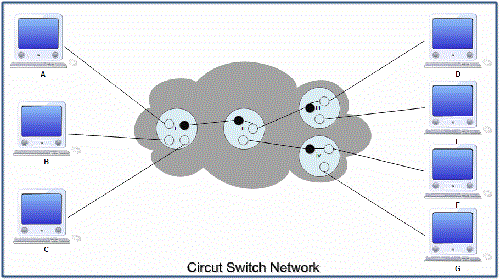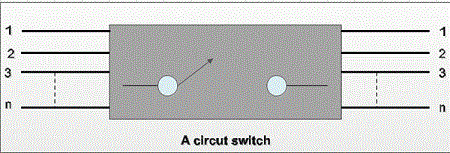Circuit switching is a switching method in which a dedicated communication path in physical form between two stations within a network is established, maintained and terminated for each communication session. It has basically three phases as circuit establishment, data transfer and circuit disconnect. The most common example of circuit switching is the telephone network.
Once the connection is established, the data transfer is transparent. The main feature of such a connection is that it provides a fixed data rate channel and both subscribers must operate at this rate, It is considered inefficient compared to packet switching because channel capacity is completely dedicated for duration of connection. If there is no data at any moment of time, channel capacity goes wasted. Moreover, setting up of connection takes time.
Circuit switching has two types of transmissions.
Datagram transmissions – Datagram transmissions have individually addressed frames.
Data-stream transmissions – Data-stream transmissions have a stream of data for which address checking occurs only once. The routing in circuit switching may have either static routing or dynamic routing. In case of static routing, this methodology uses the same approach all the time while dynamic routing allows alternate routing depending on traffic.
The Key Point of Circuit Switching are.
1. It is the simplest method of data communication in which a dedicated physical connection or path is established between the sending and receiving device.
2. In circuit switched networks, a set of switches are connected by physical links. A connection between two stations is a dedicated path made of one or more links.
3. Figure shows a circuit switched network in which computer A, B and C are connected to computer D, E, F and G via four switches. If these computers are to be connected with a point-to-point connections, 12 dedicated lines are required which will incur high line cost.
4. The four switches connecting these computers thus provide dedicated links by reducing the line cost. Here I, II, III and IV are the circuit switches or nodes. Nodes I, III, IV are connected to computers while II is only routing node.

5. In circuit switching the routing decision is made when path is set up across the network. After the link has been set between the sender and receiver, the information is forwarded continuously over the link.
6. The dedicated path established between the sender and the receiver is maintained for entire duration of conversation.
7. This link or path is released only when data transmission between sender and receiver is over.
8. Circuit switching takes place at the physical layer.
9. Before starting communication, the stations must make a reservation of resources to be used during the communication. These resources can be switch buffers, switch processing time, switch input/output ports. These resources remain dedicated during the entire duration of data transfer.
10 Data transferred between the two stations are not packetized (i.e. in form of packets). The data are a continuous flow· sent by the source station and received by the destination station and there may be periods of silence.
11. There is no addressing involved in data transfer. The switches route the data based on their occupied band (FDM) or time slot (TDM). However, there is end-to-end addressing used during set up phase.
12. In telephone systems circuit switching is used.
13. The communication in a circuit switched network takes place in three phases:
1. Circuit establishment or setup phase.
2. Data transfer phase.
3. Circuit disconnects or tears down phase.
We’ll be covering the following topics in this tutorial:
Circuit establishment or Setup Phase
In circuit switched network, before actual data transfer takes place, a dedicated circuit or path is established between the sender and receiver.
For example, if station A is willing to send a message to station C, it first sends a message to node 2, requesting a connection to station C, using the dedicated link between station A and node 2. Node 2 must find the next link in a route, leading to node 4. Based on routing information and availability, node 2 selects the circuit to node 5 and sends a message, requesting connection to station C. So far, a dedicated path has been established from station A through node 2 to node 5. Node 5 now gets a channel to node 4 and internally connects it to the previously established path. Node 4 completes the connection to station C. After completing the connection, a test is made to check whether station C is busy to accept the connection or not. That completes the circuit establishment phase.
Data Transfer Phase
Actual data transfer between the source and destination takes place after the dedicated path is set up between them.The data flows are continuous between sender and receiver. There may be periods of silence in between. Generally all the internal connections are duplex.
Circuit Disconnect or Teardown Phase.
After the completion of data transfer, the established connection is terminated, and notification signal is propagated to all the nodes in the established path to release the dedicated resources.
Circuit switching can be an inefficient technique if the channel capacity is not used properly. However, once the connection is established, data can be transmitted at full speed, supported by the channel. This makes the complete utilization of the channel capacity.

Advantages of Circuit Switching
The advantages of circuit switching are:
1. The dedicated path/circuit established between sender and receiver provides a guaranteed data rate.
2. Once the circuit is established, data is transmitted without any delay as there is no waiting time at each switch.
3. Since a dedicated continuous transmission path is established, the method is suitable for long continuous transmission.
Disadvantages of Circuit Switching
The various disadvantages of circuit switching are:
1. As the connection is dedicated it cannot be used to transmit any other data even if the channel is free.
2. It is inefficient in terms of utilization of system resources. As resources are allocated for the entire duration of connection, these are not available to other connections.
3. Dedicated channels require more bandwidth.
4. Prior to actual data transfer, the time required to establish a physical link between the two stations is too long.
 Dinesh Thakur holds an B.C.A, MCDBA, MCSD certifications. Dinesh authors the hugely popular
Dinesh Thakur holds an B.C.A, MCDBA, MCSD certifications. Dinesh authors the hugely popular